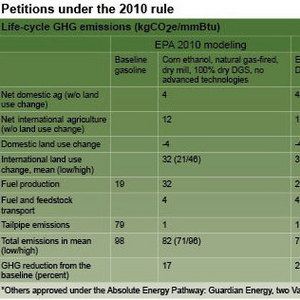First Pathway Petition Used By Few Grandfathered Corn Plants

SOURCE: EPA PATHWAY APPROVAL LETTERS FOR THE INDIVIDUAL PLANTS
February 18, 2015
BY Susanne Retka Schill
Revisions to the renewable fuels standard were authorized in the 2007 Energy Independence and Security Act, but it took EPA more than two years to flesh out the details. EISA grandfathered in existing biofuel plants, including those under construction as of December 2007, and said any new gallons must show at least a 20 percent GHG reduction when compared to the baseline gasoline.
The final rule published in February 2010 established the rules for RINs used to track the gallons applied to the different fuel categories, with existing corn ethanol plants approved to generate D6 RINs in the category of renewable fuels. In the modeling done as part of the 2010 rule, EPA found that the average dry mill using natural gas and drying 100 percent of its distillers grains realized GHG reductions of 17 percent, which included controversial international indirect land use change emissions.
The EPA also evaluated the GHG impacts of several advanced technologies, including corn oil extraction, membrane ethanol dehydration, raw starch hydrolysis and combined heat and power. The 2010 rule established three pathways for dry mills that would meet the 20 percent GHG threshold, including those drying no more than 50 percent of their distillers grains and those drying no more than 65 percent of their distillers grains, plus using one of the advanced technologies. Plants utilizing two of the advanced technologies were also determined to meet the 20 percent GHG reduction threshold. A fourth corn-starch pathway named wet mills using biomass or biogas for process heat as meeting the GHG threshold.
In essence, a big chunk of the industry’s producers processing 100 percent DDGS were limited to their grandfathered volumes, unless they petitioned the EPA. The 2010 rule established a process for producers wanting to demonstrate their efficiencies were better than the average used for the pathway modeling. A handful successfully petitioned EPA, providing data the agency used in its model to determine they met the 20 percent GHG reduction threshold. Reading the publicly available approval letters provides insights into how the process unfolded, even as the agency keeps most of the plant’s detailed information confidential, such as reported ethanol yield and actual energy use.
Absolute Energy was the first to get its petition approved in February 2013. The EPA letter of approval notes that the company reported a 16 percent improvement in energy efficiency since start up. Four other plants were approved under that pathway: Guardian Energy LLC, in Janesville, Minnesota; Valero Renewable Fuels plants in Ft. Dodge, Iowa, and Welcome, Minnesota; and Hankinson Renewable Energy in Hankinson, North Dakota. The approval letters indicate these plants met the same metrics as Absolute Energy for energy efficiency. All those under that pathway are required to demonstrate they use no more than 26,000 Btu of natural gas per gallon of ethanol produced and no more than 1,970 Btu of grid electricity.
Two other plants were approved separately. E Energy Adams’ letter includes a discussion on the accounting of energy used in a tower grain dryer at the Adams, Nebraska, plant and states the natural gas use for corn drying could be excluded, as long as it was separately metered, because it was included in the modeling for the corn feedstock. Marquis Energy-Wisconsin’s letter mentions higher electrical energy and slightly lower natural gas use at the Necedah, Wisconsin, plant than the Absolute pathway. Marquis’ letter also includes a discussion on the plant achieving ethanol yields better than the 2.71 gallons of ethanol per bushel of ethanol used by the EPA in its modeling for the 2010 rule. The accompanying chart shows the impact of improved energy efficiency and how above-average ethanol yields affect the indirect land use change modeling.
Check out a story about the new EP3 pathway petition process, for related reading.
Advertisement
Advertisement
Author: Susanne Retka Schill
Senior Editor, Ethanol Producer Magazine
701-738-4922
sretkaschill@bbiinternational.com
Advertisement
Advertisement
Related Stories
Iowa farmers have a new market opportunity for their 2025 soybean crop. Landus is expanding its Clean Fuel Regulation initiative, made possible by recent policy changes expected to increase Canada's demand for liquid biofuel.
Klobuchar, Moran introduce bipartisan legislation to support biorefineries, renewable chemicals, and biomanufacturing
Sens. Amy Klobuchar, D-Minn., and Jerry Moran, R-Kan., on July 31 announced the introduction of the Ag BIO Act. The legislation aims to update the USDA’s loan guarantee program to better support biorefining projects.
U.S. Secretary of Agriculture Brooke L. Rollins on Aug. 1 announced the opening of a 30-day public comment period for stakeholders to provide feedback on the department’s reorganization plan, as outlined in the memorandum released July 24.
Sen. Chuck Grassley, R-Iowa, on July 31 pressed Derek Theurer, President Donald Trump’s nominee to serve as under secretary of the U.S. Department of Treasury, on the expected timeline for the release of 45Z guidance.
Total U.S. operable biofuels production capacity expanded in May, with gains for renewable diesel and a small decrease for ethanol, according to data released by the U.S. Energy Information Administration. Feedstock consumption was up.
Upcoming Events










